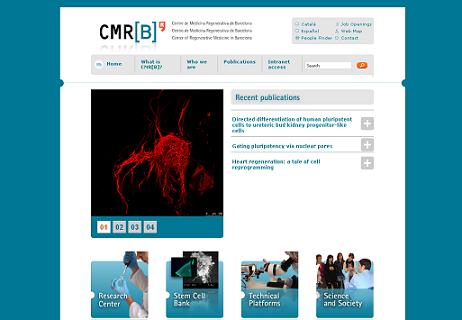First time creating “micro-kidneys” from stem cells
Researchers from Barcelona’s Centre for Regenerative Medicine (CMRB), the Catalan capital’s Hospital Clínic and the Salk Institute of California have successfully created three-dimensional renal structures which are virtually indistinguishable from embryonic kidneys. They have started creating kidney cells from human stem cells, and ultimately proven that these newly created cells could aggregate in vitro to form a “micro-kidney”. The team led by Juan Carlos Izpisúa, from the CMRB, said that this scientific breakthrough would facilitate the study of kidney diseases and enable scientists to work on new treatments. He added that this achievement was a great step towards developing therapies based on the use of stem cells.

Barcelona (ACN).- A team of researchers from Barcelona’s ‘Centre de Medicina Regenerativa’ (Centre for Regenerative Medicine, CMRB), the Catalan capital’s Hospital Clínic and the Salk Institute in California have created kidney cells from human stem cells, ultimately proving that the newly created cells were able to aggregate in vitro to form “micro-kidneys”. Indeed, these three-dimensional renal structures are absolutely indistinguishable from embryonic kidneys. The team led by Juan Carlos Izpisúa said that this scientific breakthrough would facilitate the study of kidney diseases and enable scientists to work on new treatments. He added that this scientific achievement was a great step towards developing therapies based on the use of stem cells. “The acquisition of these primordia cells makes us hopeful that one day, we can use our own cells to regenerate our ill bodies, also addressing the shortage of transplant organs” explained Izpisúa. Professionals emphasised that kidney failure was a major public health issue. They explained that in the most severe cases, such diseases are incurable and that patients require dialysis or a kidney transplant. The Catalan-led study has been published by Nature Cell Biology journal.
Stem cells are very useful in the study of many diseases and offer great potential for treatments. In order to do so, searchers need to differentiate and transform these stem cells into the cell type affected by the disease.
Until now, scientists had had little success in converting stem cells into kidney cells. However, Izpisúa’s team achieved creating kidney cells from human stem cells, also proving that the newly created cells could aggregate in culture to form three-dimensional renal structures.
The scientific article, which has been published in the prestigious ‘Nature Cell Biology’ journal, is, according to experts, “a revolution in the field of biomedicine”. The renal tissue obtained by Izpisúa’s research team is an invaluable tool for the scientific community to investigate the development of the human kidney, the various causes of kidney disease and to develop in vitro medicine testing.
A cutting-edge research
Only recently, other scientific research teams had worked on the creation of primordia (organ in its first stage of development) brain and liver from human stem cells. Thus, a Japanese group has created liver cells, and a team of searchers from Vienna a “micro-brain”. The Izpisúa kidney primordia cells complete these two scientific achievements, which had also been published in a magazine of the Nature publishing group.
A new technology for the study of kidney disease
In order to create these three-dimensional renal structures, searchers from Barcelona and California used embryonic stem cells as well as iPS cells obtained from human skin cells. The researchers developed a successful method to convert stem cells into the progenitor cells responsible for kidney filtration and collecting duct system, after only 4 days of culture.
After this first achievement, the newly created cells were put into the culture along with mice metanephrogenic blastema cells (embryonic kidney structure). The result of this experiment was that the two types of cells merged to form three-dimensional structures similar to embryonic kidney, with the collecting duct system exclusively based on human cells.
Over time, these human progenitor cells follow the development processes of human kidney. “Not only is it the first time we were able to generate renal tissues in culture, but our studies have also allowed the formation of three-dimensional structures of typical human organs”, explained one of the writers of the work, Ignacio Sancho-Martínez. “These structures allow us to study kidney development and also to investigate the causes that can lead to certain kidney diseases” added Núria Montserrat, co-author of the work.
In fact, Izpisúa’s team envisions the methodology developed as a potential platform for medicine discoveries and for modelling studies of kidney disease. In order to do so, they generated iPS stem cells from two patients diagnosed with polycystic kidney disease, a genetic disease which causes multiple cysts to form in the kidneys.
With these cells, the researchers were also able to create kidney stem cells capable of aggregating with mouse cells to form small kidney primordia, thereby proving the great value of this technology for medicine. “One of the important clinical aspects of this work is that it allows us to reproduce human kidney diseases in the laboratory, and to test different treatment strategies on in-vitro models”, explained Josep Maria Campistol, director of the Clinical Institute of Urology and Nephrology in Barcelona’s Hospital Clínic, and member of the University of Barcelona and the IDIBAPS research unit (Institut d'Investigacions Biomèdiques August Pi i Sunyer), who also took part in the study.
A giant step towards regenerative medicine
The high incidence and poor prognosis of kidney disease makes it a serious public health issue. The kidney is an organ which has little ability for self-reparation, and so it is urgent to improve scientific knowledge on its development and its functioning. Before this day, scientists had not been able to generate kidney cells in culture, and this is a milestone in research on kidney disease. In addition, the kidney has a complex three-dimensional structure, which involves many different cell types. This new study, which addresses the creation of “micro” renal collecting duct systems, is a leader in the field of kidney regeneration, and put us one step closer towards the goal of creating functional kidneys from stem cells.